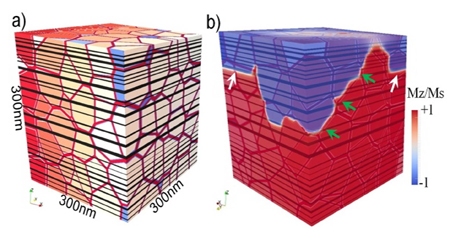(ESICMM-G8 Symposium on Next Generation Permanent Magnets, Tsukuba, 2015)
Influence of defects to the coercivity of permanent magnets and energy density of nanocomposite magnets; a micromagnetic simulation study
H. Sepehri-Amin1, T. Ohkubo1, T. Schrefl2, and K. Hono1
1 National Institute for Materials Science, Tsukuba 305-0047, Japan
2 Center for Integrated Sensor Systems, Danube University Krems, Austria
Abstract:

Figure 1. (a) Modeled Sm2Co17 magnet and (b) a snap shot of magnetization
reversal showing pinning of domain walls at the SmCo5 cell boundary phase,
green arrows, as well as Zr-rich layers, white arrows.
Finite element micromagnetic simulations enable to obtain a fundamental understanding on the correlation between microstructure and magnetic properties of permanent magnets. In the first part of this talk, a few examples will be presented on how micromagnetic simulations can explain high coercivity in Sm2Co17-type and SmCo5-type permanent magnets. Sm2Co17-type magnet was modeled based on the microstructure observations (Fig 1(a)). Micromagnetic simulations of magnetization reversals of high coercivity Sm2Co17 based permanent magnets showed two types of pinning sites; SmCo5 cell boundaries (green arrows in Fig. 1 (b)) and Zr-rich Z-phase (white arrows in Fig. 1 (b)). In the case of SmCo5-based isotropic magnets, a high coercivity of 6.8 T has been realized [1]. Microstructure observations of an isotopically grown film has shown that stacking faults in the SmCo5 grains lead to the formation of SmCo3, Sm2Co7, Sm5Co19 phases locally inside of SmCo5 grains. Micromagnetic simulations showed that pinning of domain walls at the SmCo3/SmCo5 interfaces combined with pinning at the grain boundaries of isotropic SmCo5 grains lead to the high coercivity in isotropic SmCo5-type film.
In the second part of this talk, correlation between the grain surface defects and (BH)max of anisotropic nanocomposite Nd2Fe14B/Fe system will be addressed. Although many numerical modeling studies have been carried out to predicted very high energy density for various types of anisotropic nanocomposite magnets, the effect of microstructure defects that causes locally low magnetocrystalline anisotropy have not been taken into account [2,3]. Considering realistic grain surface defects, (BH)max of nanocomposite Nd2Fe14B/Fe system can have maximum 12% enhancement of (BH)max in the layered α-Fe/ Nd2Fe14B structure. The effect of the grain boundary defect on (BH)max of nanocomposite magnets with various geometry of Fe phase and exchange coupled and decoupled Nd2Fe14B grains will be addressed.
[1] O. Akdogan. H. Sepehri-Amin et al. Advanced. Electronic Mater. in press.
[2] R. Skomski et al. Phys. Rev. B 48 (1993) 15812.
[3] H. Fukunaga et al. IEEE Trans. Magn. 49 (2013) 3240.
